
I agree Our site saves small pieces of text information (cookies) on your device in order to deliver better content and for statistical purposes. You can disable the usage of cookies by changing the settings of your browser. By browsing our website without changing the browser settings you grant us permission to store that information on your device.
Mutant mouse and rat technologies represent a powerful means to investigate the genetic basis of behavior and to elucidate the mechanisms underlying neurological and psychiatric disorders.
The Neurobiology and Behavior platform has developed a battery of tests adapted to the murine model. These tests include analyses of sensory responses, motor abilities, cognitive functions as well as behaviors related to neuropsychiatric disorders, such as anxiety, depression or schizophrenia.
Tests may be used as a package for phenotyping genetically modified mice and rats or to screen for potential therapeutics. Alternatively, a panel tests may be customized with our expert consultancy for rapid and targeted discovery.
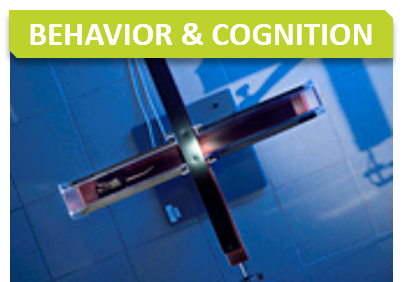
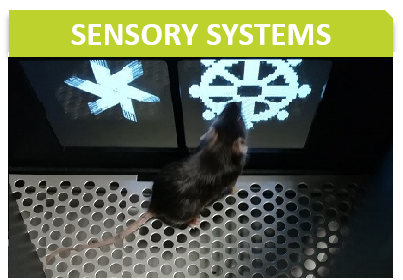
The startle is a reflexive response to strong exteroceptive stimuli (acoustic or tactile). Pre-pulse inhibition (PPI) is the normal reduction of the startle reflex to an intense stimulus (acoustic or tactile) when this stimulus is immediately preceded by a non-startling prepulse. PPI provides an operational measure of sensorimotor gating which reflects the ability of an organism to properly inhibit sensory information. Amplitude of startle might give indication about motor deficits or anxiety. This assay could also be used to analyze depression-like behavior.
Eight startle chambers (SRLAB, San Diego Instruments, San Diego, CA) are used for evaluation of the acoustic or tactile startle.
10 mice per group are recommended for reliable data analysis.
Under constant environmental conditions, mice demonstrate circadian and ultradian periodicity of activity and feeding behavior, which is driven by an endogenous clock located in suprachiasmatic nuclei in mammals.
Measurement of spontaneous activity and food/water intake allows evaluation of biological rhythm and sleep abnormalities.
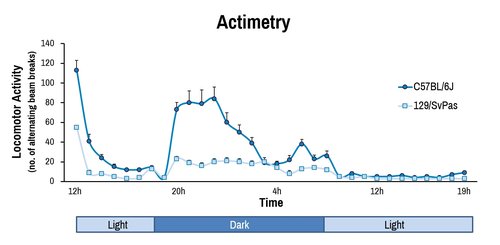
Strain comparison between C57BL/6J and 129/SvPas over 32 hours with noted hourly measure of locomotor activity. Light and dark phase intervals are noted. Food and water measures are made concurrently.
The active avoidance test assesses cued evasion of an aversive stimulus. The mouse is trained during the acquisition period to escape the aversive stimulus, after which the extinction of the trained behaviour is measured. We offer varied acquisition and extinction periods to fit your needs and budget. Locomotion, severe vision and other sensory defects can effect this test.
C57BL/6N mice treated with scopolamine or vehicle prior to training. Scopolamine-treated animals do not improve cued responses indicating a failure to learn.
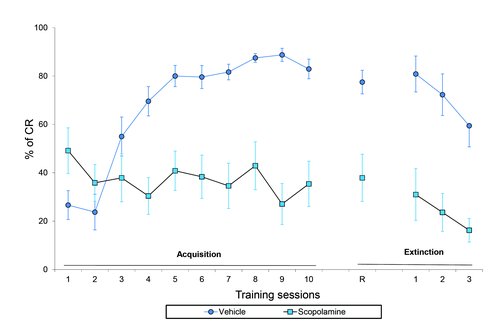
Scopolamine treatment prior to active avoidance testing inhibits learning. Evolution of cued responses (% of CR) in C57BL/6N mice during acquisition and extinction phases of active avoidance. Retention test (R) occurs 17 days after final acquisition session. Sessions in extinction phase are performed without aversive stimulus. Data points reflect Mean ± SEM (n=12).
Automated shuttle boxes (PanLab, Spain)
12 animals per group are recommended for reliable data analysis (alpha=0.05, beta=.2, D=1, Wilcoxon-Mann-Whitney test).
The amphetamine-stimulated locomotor activity (Amphetamine-stimulated LMA) assay is used to evaluate the behavioral response elicited by i.p. injection of amphetamine. It induces psychotic symptoms via an increase in dopaminergic signalling and is relevant to neuropsychiatric disorders.
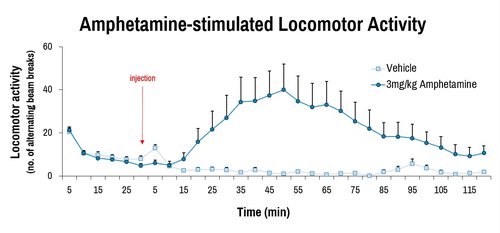
3mg/kg injection into C57BL/6N induces locomotor activity. Dose is maintained below saturation in order to see both increased and decreased amphetamine sensitivity.
Studies of angiogenesis benefit from the ability to non-invasively examine eye vasculature. This technique makes use of fluorescent dyes to demarcate blood vessels and examine vascular dynamics over time.

Flourescent imaging of the fundus after intravenous injection of fluorophores (fluorescein and Evan’s blue) or cellular GFP expression in a transgenic mouse.
This is an associative learning paradigm for measuring emotional learning and memory. A neutral conditioned stimulus (CS, tone) is paired with an aversive unconditioned stimulus (US, foot-shock). After conditioning, the CS or the spatial context alone elicits a central state of fear expressed as reduced locomotor activity or total lack of movement (freezing).
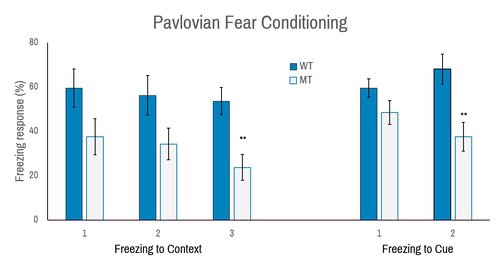
Comparison of wild-type (WT) and Atp6ap2 brain-specific deletion (MT) in fear-conditioning response as described in Dubos et al. (2015). Mutant mice are show reduced freezing to context and to cue. **, p<0.01.
Dubos, A. et al. Human Mol Genet. 2015. 24(23):6736-55.
4 automated cages (Coulbourn Instruments, Whitehall, USA)
10 mice per group are recommended for reliable data analysis.
Similar to auditory test in clinical settings, the ABR provides a measurement of the sensorineural as well as conductive hearing impairment by directly examining the neuronal excitation elicited by auditory stimuli.
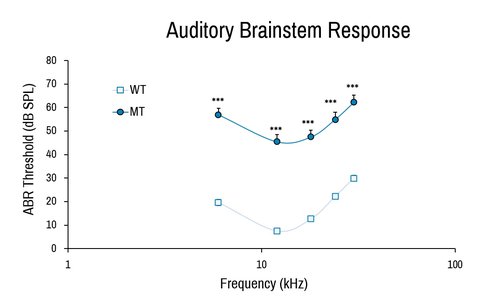
Comparison of wild-type (WT) and Baiap2l2 deletion (MT) female in auditory brainstem response. The severe deafness of the Baiap2l2 mutant results in much higher ABR threshold measurements. ***, p<0.001
Gait analysis evaluates proprioceptive sensitivity but also assesses the integrity of motor coordination and vestibular function. Animals require an accurate paw placement to succeed in this test. The gait is altered in in different pathologies including ataxia or neuropathic pain.
Sample test results:
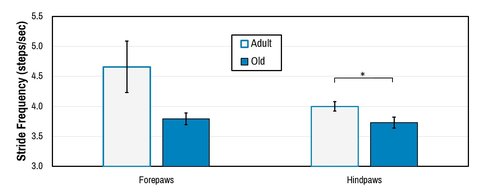
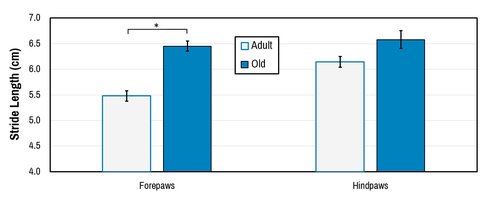
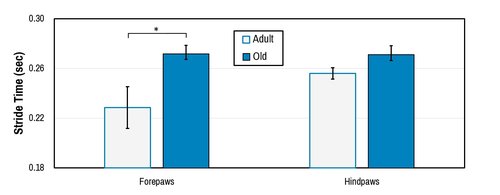
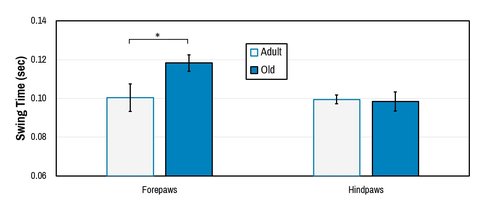
Hansen and Pulst, 2013.
Digigait™ (Mouse Specifics, Inc.) transparent treadmill instrumentation.
10 mice per group are recommended for reliabe data analysis.
The balance beam test or gait analysis is relatively specific for evaluation of proprioceptive sensitivity. However, the performance in this test also depends on the integrity of motor coordination and vestibular function.
An elevated beam of standardized diameter and length.
10 mice per group are recommended for reliable data analysis.
The startle reflex is a ubiquitous, cross-species integrated reflexive response to strong exteroceptive stimuli. Prepulse inhibition (PPI) is the normal reduction of the startle reflex to an intense stimulus (acoustic or tactile) when this stimulus is immediately preceded by a non-startling prepulse (auditory, visual or tactile stimuli). PPI phenomenon is viewed as an operational measure of sensorimotor gating, which reflects a basic inhibitory process that regulates sensory input to the brain and allows the early stage of information processing to occur without disruption. Deficits in PPI have been observed in several neuropsychiatric disorders characterized by a loss of normal ability to filter or gate intrusive or irrelevant sensory, motor or cognitive information such as schizophrenia, obsessive-compulsive disorder and Huntington’s disease. With the present procedure, various protocols are used in which stimuli of different modalities and duration (acoustic, tactile and visual) are used alone or in combination in order to assess startle respones and cross-modal prepulse inhibition of startle reflex.
Monitoring electrophysiological activity in the brain through multiple electrical leads is very pertinent to seizure disorders.
Electromyographic recording allows neurophysiological measurement of sensory-motor function. In situations of demyelination and/or axonal degeneration, the compound muscle action potential (CMAP), latency of motor response and sensitive nerve conduction velocity (SNCV) are affected.
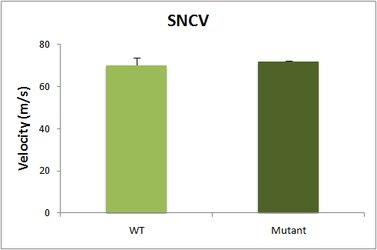
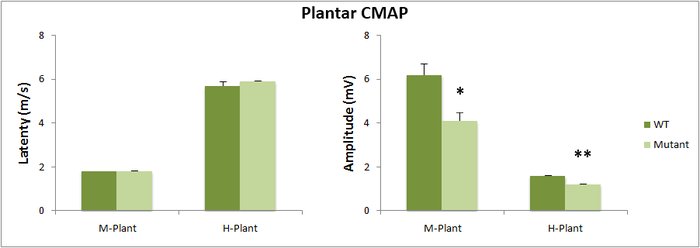
Key Point electromyograph (EMG) apparatus (Medtronic, Boulogne-Billancourt, France). The body temperature is maintained at 37 °C with a homeostatic blanket (Harvard, LES ULIS, France).
10 mice per group are recommended for reliable data analysis.
Electroretinography evaluates in vivo the activity of retinal cells, from photoreceptors (a-wave) and inner retina neurons (b-wave, oscillatory potentials). Activity of rod or cone circuits can be isolated by dark- or light-adaptation of the retina, as well as changing the stimuli frequency.
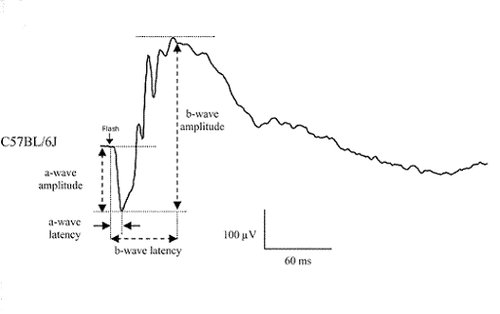
Example of classical ERG recording from a C57BL/6 mouse under scotopic condition. The a-wave amplitude and latency provide information on photoreceptor function while the b-wave amplitude and latency are indicative of postsynaptic neuronal function. Different light stimuli can selectively activate either the rod or the cone pathway.
Siem Visiosystem (Siem Bio-Médicale, Nîmes, France)
The elevated plus maze test allows an evaluation of anxiety for height. Animals are confronted to a choice between threatening environment, an exposed runway elevated from the floor, and relatively safe enclosure. An anxious animal will normally choose to spend time in the closed arms and rarely venture out onto the open arms.
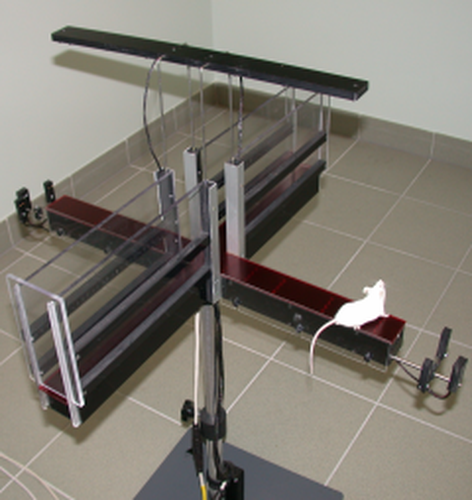
An automated elevated maze device (Imetronic, Pessac, France).
10 mice per group are recommended for reliable data analysis.
In the forced swim procedure, mice are forced to swim in unescapable situation. After a period of vigorous struggling, the animal becomes immobile, or makes only those movements necessary to keep its head above the water. The immobility observed in this test is considered to reflect a state of despair.
Glass beakers filled with water at 22-23 °C.
10 mice per group are recommended for reliable data analysis.
Formalin tests allows evaluation of chronic inflammatory pain.
10 mice per group are recommended for reliable data analysis.
Fundus imaging allows detecting anomalies in retinal structure, pigmentation and/or vasculature, as occurring in various retinal diseases as retinitis pigmentosa (RP), glaucoma and other types of retinal degeneration. This can be combined with OCT to help precise the localization of retinal lesions. In addition, the high sensitivity of the Micron III allows in vivodetection of fluorescent proteins or markers, for instance for longitudinal follow-up of cell populations expressing GFP or RFP, or monitoring the efficacy of viral infection (gene therapy).
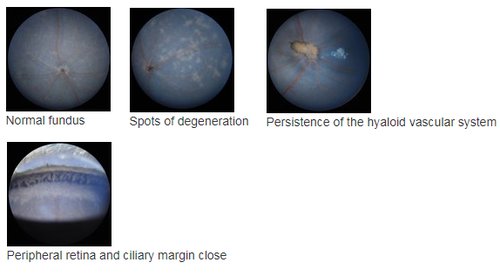
Micron IV with GFP and RFP filters (Phoenix Labs, Pleasanton, CA, USA)
TEFI (Paques et al., IOVS 2007), which can be brought to other animal facilities if needed due to sanitary status of the animals.
This test measures the muscular muscle strength using an isometric dynamometer connected to a grid. Once the animal is holding the grid with its forepaws it is slowly moved backwards until it releases it. The dynamometer records the maximal force exerted.
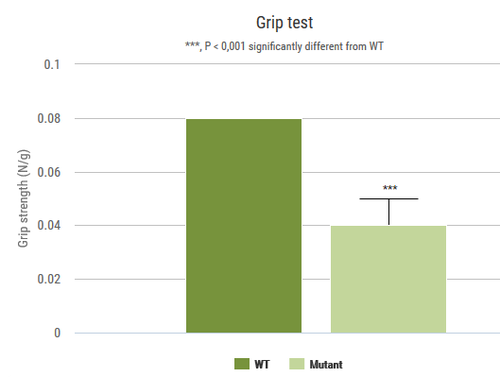
2 grip strength apparati (BIOSEB, Vitrolles, France).
10 mice per group are recommended for reliable data analysis.
The hot plate test is used for evaluation of response to acute thermal pain.
The mice are placed into a glass cylinder on a hot plate adjusted to 52°C and the latency of the pain reaction (licking, moving the paws, little leaps) is recorded.
Hot plate (Panlab, Barcelona, Spain).
10 mice per group are recommended for reliable data analysis.
Mice are social creatures and develop in group settings but most learning and behavioral tasks are limited to individual mice. IntelliCages allow cognitive and behavioural evaluation in a social environment using transponder technology, which also drastically reduce human involvement at the time of study.
The light-dark test allow an evaluation of emotional responses of animals in a highly illuminated situation. Mice will normally show a preference for the dark compartment, but they also exhibit some incursions into the lit compartment. Aberrant behavior may indicate changes in anxiety.
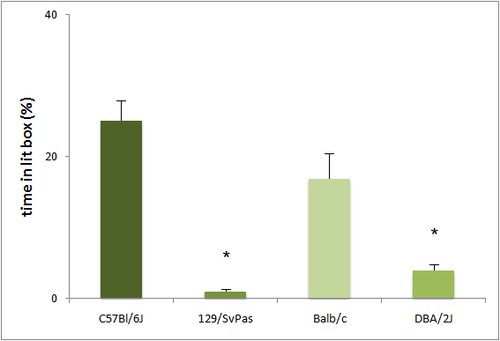
4 automated light/dark boxes (Imetronic, Pessac, France).
10 mice per group are recommended for reliable data analysis.
This test is used to evaluate spatial reference memory in rodents. Mice are trained to escape from water by swimming to a submerged platform using only distal extra-maze cues.
2 rooms dedicated to water maze test and videotracking systems are used (Ethovion, Noldus)
10 mice per group are recommended for reliable data analysis.
The MoRaG test consists of a semiquantative and quantitative assessments of reaching and grasping behavior in mice. These fine-tuned motor abilities are altered in neurological diseases such as Parkinson’s disease. In this test, mice submitted to food restriction are forced to use a single paw instead of their mouth in order to get a small food pellet.
A proprioceptive test similar to the balance beam under more challenging condition requiring vertical as well as lateral movement. This test also depends on the integrity of motor coordination and vestibular function.
The object recognition task is based on the natural tendency of rodents to explore a novel object / environment in comparison to a familiar one. This test allows evaluation of recognition memory to characterize potential memory defects.
Automated openfield arenas (Panlab, Barcelone, Spain) and different objects (marble, dice…) are required.
10 mice per group are recommended for reliable data analysis.
Object recognition and object location are based on the natural tendency of rodents to explore a new object / environment as compared to a familiar one. These protocols allow evaluation of working / recognition memory.
The one-meter swim test is used to evaluate swimming ability of mice.
A straight swim tank (100 cm long, 6 cm wide, 27.3 cm high) made of translucent PVC and filled at 21 cm depth with water. A visible platform is placed opposite to the starting point, allowing to the animal to escape from water.
10 mice per group are recommended for reliable data analysis.
This test is used to evaluate exploratory drive, reactivity to novelty and emotionality. Habituation to the open field, which is a form of non-associative learning, is also measured.
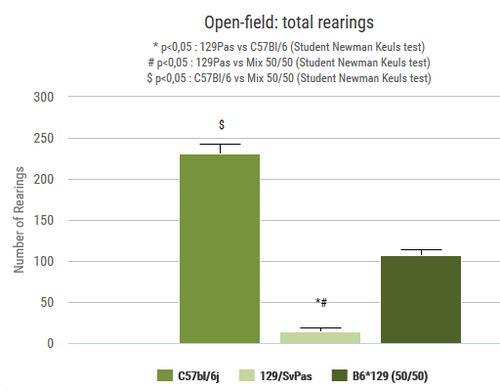
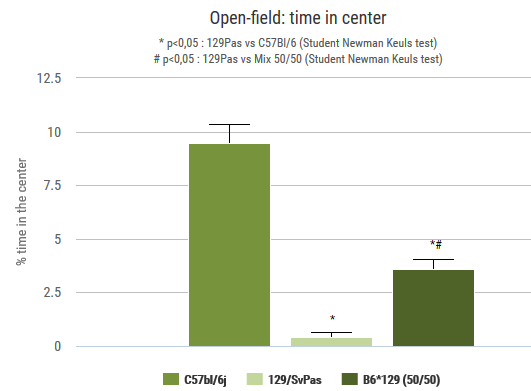
4-8 automated openfield arenas (Panlab, Barcelona, Spain).
10 mice per group are recommended for reliable data analysis.
Non invasive in vivo histology of the retina with 2-3 µm axial resolution, allowing precise thickness measurement of all retina layers, including photoreceptor segments. Sites (and size) of retinal lesions can thus be identified, and their evolution tracked over time, either to characterize a disease progression, of the efficacy of a pharmacological or gene therapy treatment.
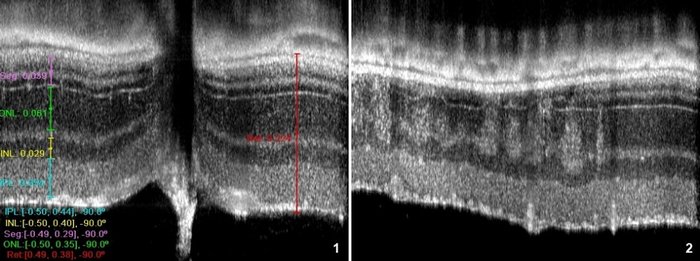 OCT allows measuring the various retinal layers with 2-3 µm precision in the optical axis (1), and detection of retinal lesions, as in (2) representing a transition between a non-affected area (right) and a zone with spots of degeneration caused by the rd
OCT allows measuring the various retinal layers with 2-3 µm precision in the optical axis (1), and detection of retinal lesions, as in (2) representing a transition between a non-affected area (right) and a zone with spots of degeneration caused by the rd
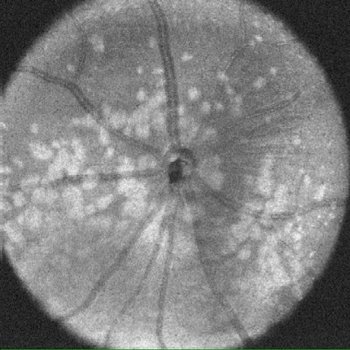 The distribution of lesions in the retina can be visualized by “en face” views, which can be focused on a given retinal layer.
The distribution of lesions in the retina can be visualized by “en face” views, which can be focused on a given retinal layer.
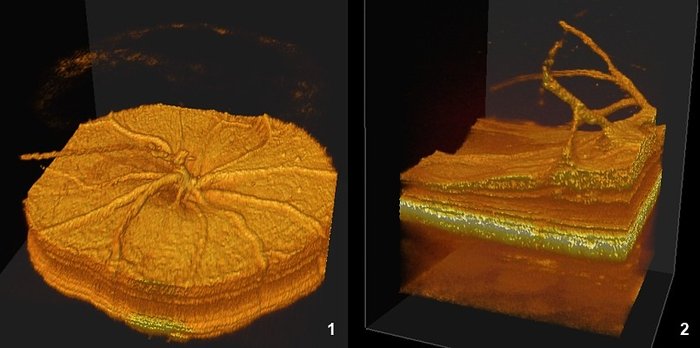 Data can be visualized in 3D to better visualize some anomalies, as a partial vessel detachment from the retinal surface and persistence of a hyaloid vessel (1), or a more severe alterations with retinal thinning and persitence of many hyaloid vessels in
Data can be visualized in 3D to better visualize some anomalies, as a partial vessel detachment from the retinal surface and persistence of a hyaloid vessel (1), or a more severe alterations with retinal thinning and persitence of many hyaloid vessels in
Bioptigen EnVisu R2200 (Bioptigen, Durham, NC, USA)
The optomotor test is based on the reflex tracking of moving objects in the visual field. While in humans this is achieved essentially through the optokinetic reflex, involving only eye movements, mice tend to follow moving objects through head movements, than can be easily visualized either in normal or low light conditions (with IR illumination). Mice are placed in the center of a rotating drum, which inside wall is covered with alternating black and white stripes, with spatial frequencies ranging from 0.03 to 1.25 cycles/degree (standard spatial frequency for first line testing is 0.26 cycle/degree). Head tracking of the bar movements is absent in blind animals. Visual acuity can be assessed by changing the bar spatial frequency. Absence of head tracking can have many origins. Notably albinos strains do not respond to the optomotor test, due to a defect in projections of the ganglion cells involved in this reflex.
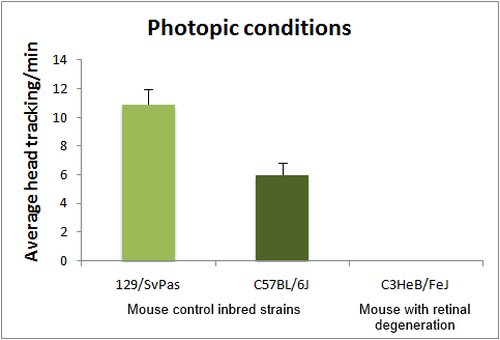 Head tracking are quantified by scoring either the number of head movements per minute or averaging the total tracking time per minute.
Head tracking are quantified by scoring either the number of head movements per minute or averaging the total tracking time per minute.
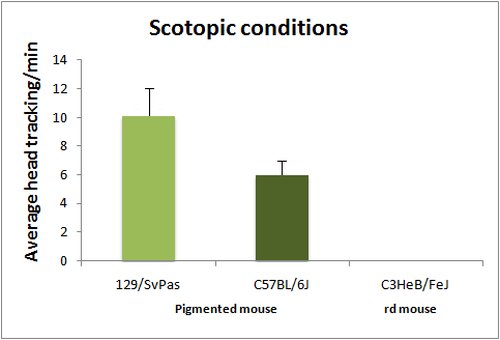
Head tracking are quantified by scoring either the number of head movements per minute or averaging the total tracking time per minute.
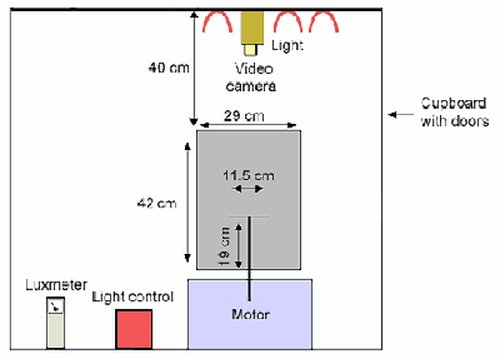
Schematic diagram showing the dimensions of the visual tracking drum. Drum dimensions, diameter 29.0 cm, height 42.0 cm. The mouse is placed on a stationary grated platform of 11.5 cm diameter and raised above the floor of the drum by 19 cm. The drum is housed within a cupboard, with a stabilising arm fixed 40 cm above the mouth of the drum. This arm is to hold the video camera. Three 60 watt bulbs are 40 cm above the mouth of the drum and are operated via a light control.
This test is frequently used for screening of the potential antiepileptic drugs and is based on the excitotoxic properties of pentylene-tetrazol (PTZ). This substance acts as a non-competitive GABA-A receptor antagonist that reduces neuronal inhibition.
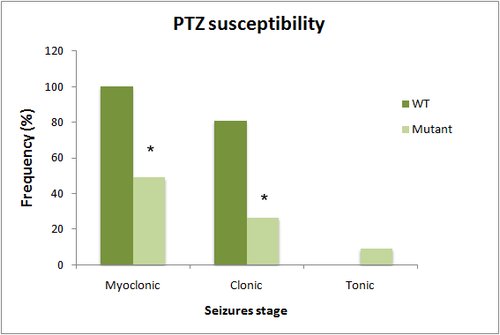
Example of results obtained with mutant mice. At the dose of 40 mg/kg IP, PTZ induced myoclonia in all animals and clonic seizures in 80% of mice from the control group. Mutant mice showed decreased susceptibility to PTZ; only 50% of mutant mice shows myoclonic seizures and 25% clonic seizures [W2 = 7.4, p < 0.01 vs WT].
10 mice per group are recommended for reliable data analysis
This test measures the ability of an animal to maintain balance on a rotating rod. This task requires a variety of proprioceptive, vestibular and fine-tuned motor abilities.
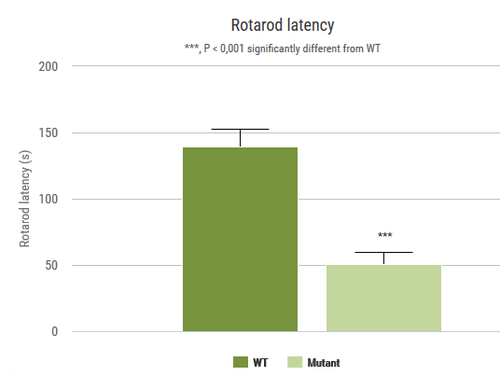
2 rotarod apparati (BIOSEB, Vitrolles, France)
10 mice per group are recommended for reliable data analysis.
This procedure is used to assess sensitivity to electrical footshock, and is a critical control for procedures requiring foot-shocks (i.e, aversive learning).
Fear conditioning equipment (Coulbourn Instruments, Whitehall, USA)
10 mice per group are recommended for reliable data analysis.
General ophthalmic observation to detect gross eye or eyelid defects (microphthalmia, eyelid closure, bulging eye, corneal opacities, lack of pupil response to changing light level...), followed by a detailed examination of the anterior segment of the eye (cornea, aqueous humor, lens, and vitreous) with a thin (slit) illumination, to better visualize anomalies in these transparent compartments. This test does not require anesthesia, as the anterior segment can be well-observed on vigil mice gently hand-held. Digital imaging can be obtained from anesthetized mice.
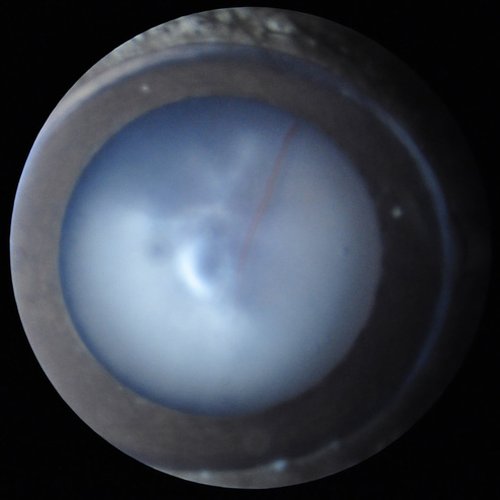 Cataract
Cataract
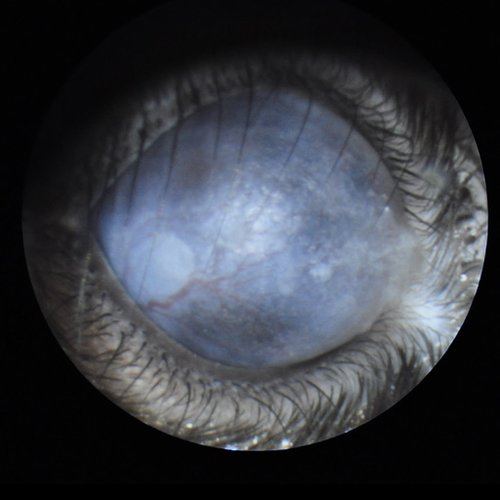 Corneal opacity with neovascularization
Corneal opacity with neovascularization
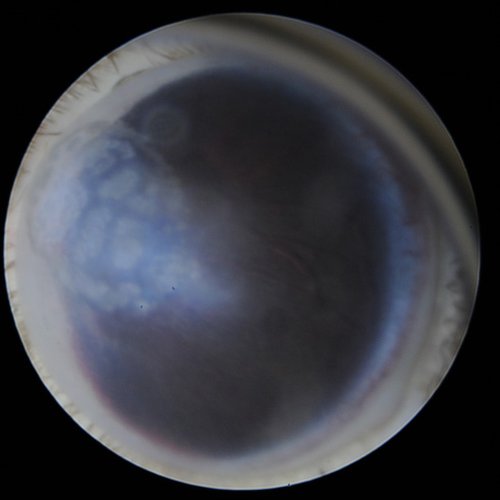 Corneal mineralization
Corneal mineralization
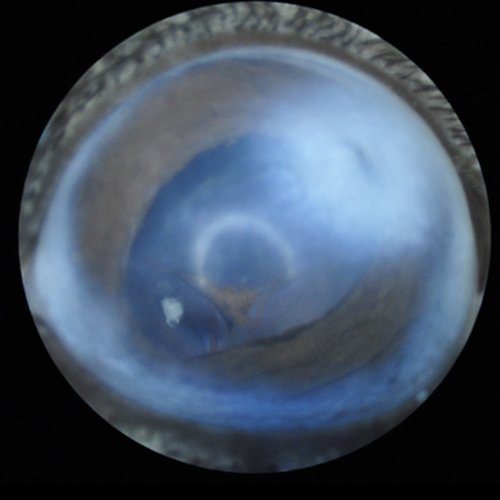 Corneal opacity with abnormal pupil shape close
Corneal opacity with abnormal pupil shape close
All images taken with TEFI (Nikon DSLR + 85 mm f/1.8 lens, coupled to an Hopkins endoscopic optic).
SL-990 Slit Lamp (CSO, Firenze, Italy)
Micron III with slit lamp extension (Phoenix Labs, Pleasanton, CA, USA)
Social recognition test evaluates the preference of a mouse by measuring exploration of a novel congener as compared to a familiar one. Social behavior is altered in several diseases such as autism and mental retardation.
Social interaction is evaluated using pairs of mice from different housing cages, by measuring different behavioral parameters reflecting social interaction between the two individuals (following, sniffing and pawing). Social behaviour is altered in neuropsychiatric diseases like Autism spectrum disorders.
Social recognition test evaluates social preference (the preference of a mouse for a congener as compared to an object) or social memory (novel versus novel congener). Social behavior is altered in several diseases such as autism and mental retardation.
Stereotactic administration is widely used for brain manipulation. With the development of gene therapy, the injection of viral vectors into specific brain structures is a valuable technique in the study of treatments for brain diseases.
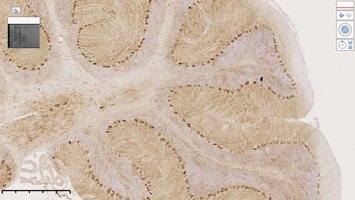
Legend: cerebellum mouse slice, stained with an HA antibody to detect « confidential » transgene expression after intra cerebellar AAV delivery using stereotactic technics. Francoise Piguet © IMC
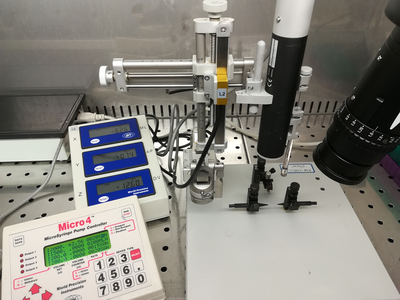
Legend: automated intracerebral injection system for mouse and rat models.
The string test measures the time required for a forelimb-hanging mouse to gain hindlimb traction. Defects in latency time reflect potential alteration in traction force, drug-induced sedation, or deficient coordination (Meziane et al. 1996).
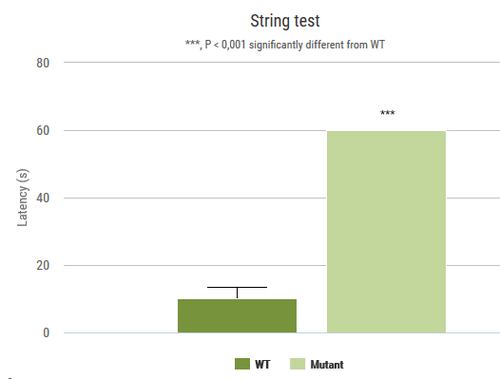
Customized equipment: a wire stretched horizontally 40 cm above a table.
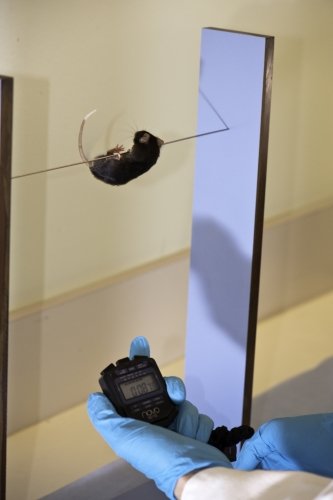
10 mice per group are recommended for reliable data analysis.
Anhedonia, or reduced sensitivity to pleasure, is one of the core symptoms of depression which can be modeled in animals. The hedonic behavior can be evaluated by measuring the preference for sucrose when the animal has free access to two bottles containing either a sucrose solution or water.
Specific bottles for evaluation of liquid consumption.
10 mice per group are recommended for reliable data analysis
The tail flick test measures a simple spinal reflex to a sudden painful thermal stimulus.
A photobeam is used to apply a heat stimulus to the tail, and the time to flick the tail out of the path of the light beam is measured.
Tail flick equipment (Panlab, Barcelona, Spain)
10 mice per group are recommended for reliable data analysis.
The tail suspension test is among the most widely utilized rodent model of depression. When mice are suspended by the tail to a tail hanger, they will normally undertake an initial period of vigorous struggling after which the animal gradually abates into immobility. The duration of immobility has been inferred as an index of behavioral despair.
2 automated cages are used (MED Associates Inc, St Albans, Vermont).
10 mice per group are recommended for reliable data analysis.
Touchscreen technology allows to explore cognitive deficits with a platform that is translatable across rodents, non-human primates and human subjects (Palmer et al., 2021) lending itself to a high degree of standardization and throughput.This methodology is low stress, using appetitive rather than aversive reinforcement.
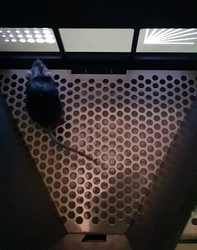
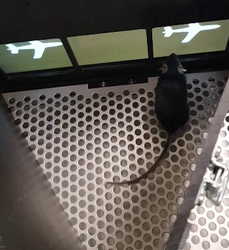
In addition to the traditional behavioral tests used to study cognitive skills, such as novel object recognition, Morris water maze, and fear conditioning, PHENOMIN-ICS has implemented a touchscreen pipeline to assess visual discrimination, cognitive flexibility, and spatial learning.
After pre-training to learn to press an image that appears on the screen in order to obtain a reward of sweet water, the mice are tested in 3 different protocols.
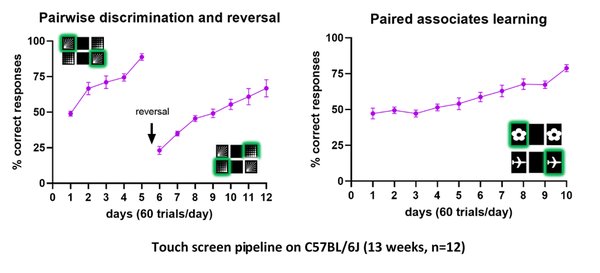
12 Mouse Touch Screen Systems (Campden Instruments)
Strawberry syrup
12 mice per group are recommended for reliable data analysis.
Mice communicate in frequencies that are ultrasonic to the human ear. Recording and replaying of ultrasound vocalizations in response to particular social interactions may indicate aberrant social behavior, such as those in autistic disorders.
Mechanical nociception assay that quantitatively gauges withdrawal thresholds for stimulation of the hindpaw with different sized fibers.
This test allows evaluation of working memory. When placed in the Y-maze, mice tend to alternate visits between the three arms. A mouse with impaired working memory cannot remember which arm it just visited and thus shows decreased spontaneous alternation.
Home-made equipment made of PVC.
10 mice per group are recommended for reliable data analysis.